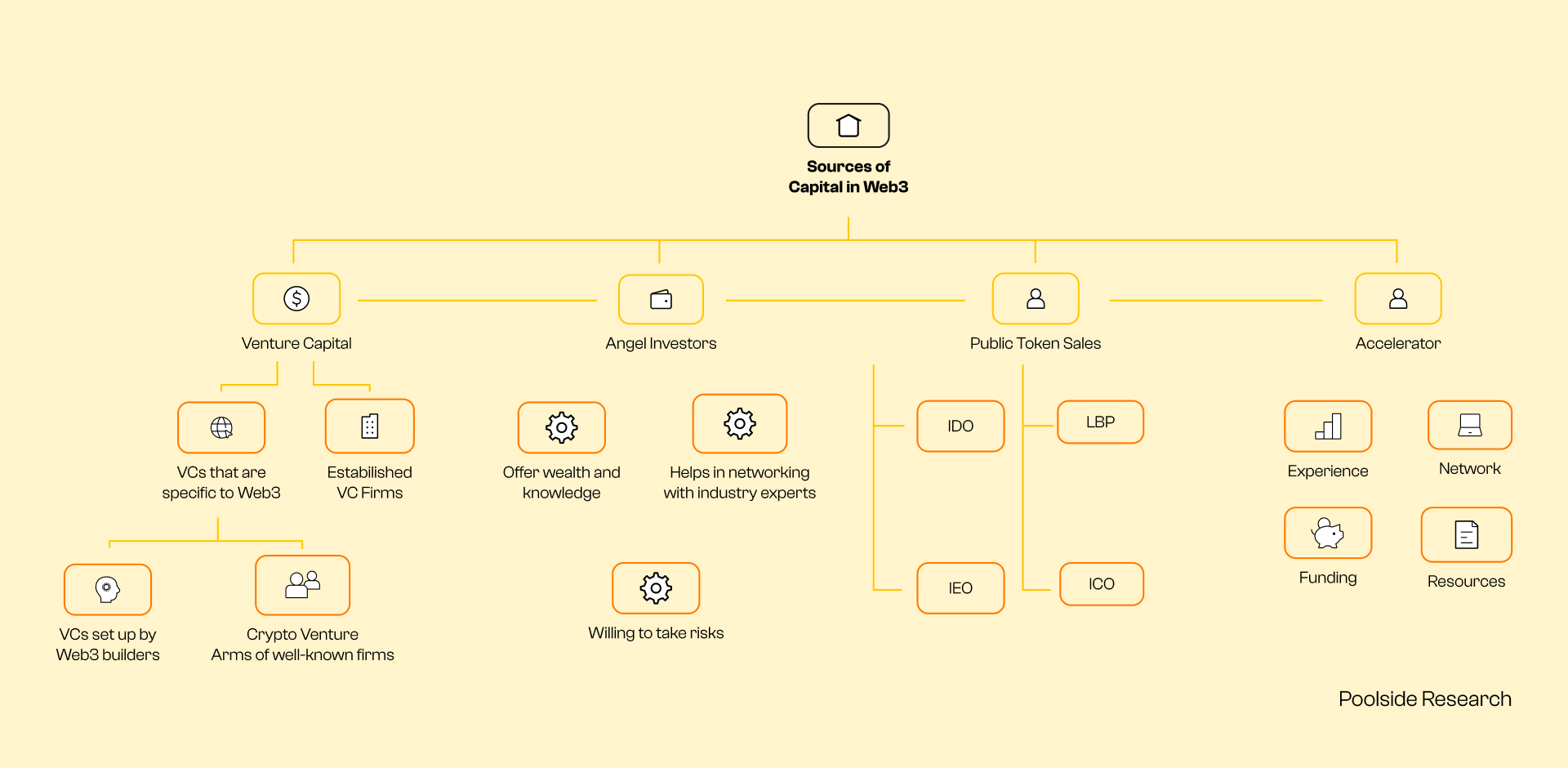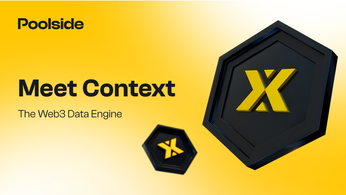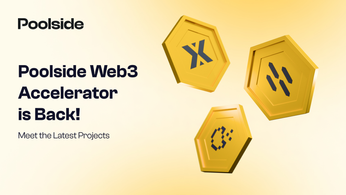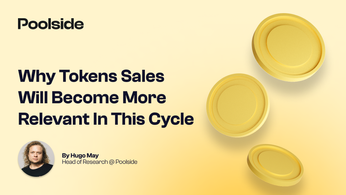
Raising Funds in Web3: Exploring the Many Paths to Success
An In-Depth Overview of the Most Effective Fundraising Methods in the Crypto Space

Fundraising is hard, especially in Web3. With so many options available, it can be challenging to know which approach is right for your project.
In this article, we'll explore the different approaches to fundraising in Web3, weighing the pros and cons of each method so you can make an informed decision.
Unique to web3: Tokens vs Equity
To determine the type of investor and sale that fits best with your fundraising strategy, you first need to identify what you are selling.
While equity has traditionally been the asset for sale, it is now common to raise capital through the sale of tokens in web3 or a combination of both.
The choice of what to sell during a fundraise should be made by the founders in consultation with their legal and other advisors experienced in web3 fundraising.
However, before making this choice, it's important to understand the key differences between equity and tokens.
Equity
- Provides value accrual to investors via revenue-sharing mechanisms such as dividends.
- Takes 7-10 years before the stocks of a company are publicly traded, resulting in a longer exit period for investors.
- Is regulated by long-standing frameworks, limiting what you can and can't do and say during a fundraise.
- Generally not used to reward contributors due to regulatory complexity.
Tokens
- Does not provide value accrual through revenue-sharing mechanisms such as dividends.
- Has rapid liquidity, as tokens are much faster released to the public, providing a quicker exit for investors.
- Is subject to regulatory scrutiny, and must be a true utility token to avoid being classified as a security.
- Allows for a direct reward of contributors through airdrops, campaigns, and other forms of value recognition.
This chart compares equity and tokens as fundraising assets.
Ultimately, the decision to sell equity or tokens depends on the unique needs of your project and the advice of legal and other advisors experienced in web3 fundraising.
Documentation for tokens and equity
For you to be able to sell either tokens or equity or both, you need to have the proper documentation in place so you and the investors can legally sign off on the sale. The following are the standard documents used in fundraising:
Equity
- Standard agreement among startups is the Simple Agreement for Future Equity (SAFE)
- Investor receives a right to future equity based on agreed-upon terms
- Quick to understand, costs less than standard equity sale procedure, and brings fewer complexities
- Click here for an overview of the different types of SAFE agreements possible.
Tokens
- Variant of the SAFE for tokens is called the Simple Agreement for Future Tokens (SAFT)
- SAFT is a contractual agreement in which an investor agrees to buy a specific amount of tokens at a future date, typically just prior to the public release of a token
- Click here to learn all about the SAFT
Token warrants
- Token warrants are a relatively new and complex instrument
- They represent a right, but not an obligation, to purchase future tokens at a specified price at or before a specified date.
- To learn more about this structure, click here.
Sources of capital in web3
After determining what to sell and how to structure it, it's important to consider the various parties you can raise capital from. This chart provides an overview of the different types of investors typically active in the start-up market.
Below we'll focus on those who often invest in web3 fundraises.

Venture capital
Overview
- Venture Capital (VC) firms provide the most funding in Web3
- VCs have been around since the early 20th century and specialize in start-ups
- VCs specialize in a specific industry, such as Web3
Selection Process
- VCs see dozens to hundreds of pitches per month
- They are aware of the high failure rate among start-ups
- VCs select projects for their portfolio, that they believe could do well in the future
- They take their time, conduct multiple meetings, and have high standards of due diligence before deciding to invest
- The capital VCs manage on behalf of others varies from the millions well into the tens of billions.
Working with VC
- Building a relationship with the VC is crucial
- Expect to have multiple meetings with various partners of the VC and have your project scrutinized from top to bottom
- You also have to do your due diligence and decide whether you want to work with a VC or not
- A serious VC will be with you for the long run, and the relationship between your start-up and a VC can become similar to a marriage.
Angel Investors
Angel investors can be a valuable source of funding for Web3 startups. They typically invest their own money and are often successful entrepreneurs, protocol or dApp builders, or crypto influencers who have come into wealth during bull runs.
Compared to VCs, angel investors can make investment decisions faster, but they may offer less professional assistance and networking opportunities. In Web3, there are many angel investors due to the public nature of the market, but it's important to ensure that your interests align with theirs and that they can offer more than just capital.
In summary, while angel investors may not bring as much to the table as VCs, they can still be a valuable source of funding for Web3 startups, especially if they have relevant industry experience and can offer strategic guidance.
Public token sales
Token sales have become highly popular in web3 as a crowdfunding method, allowing the larger public to invest in early-stage projects. While this method has its downsides, such as the potential for scams and bad ideas, it can be a great way to raise capital from early supporters if executed with integrity.
However, token crowdfunding is unsuitable for projects with high expenses before product release. Below we will explore various methods for public token sales.
Initial Coin Offerings (ICO)
ICOs become popular, really popular, during the bull run of 2017. They were simple yet effective; the token sellers opened a wallet and a contract, and buyers could send ETH to the wallet and in return, they received a token.
While popular, ICOs also have their fair share of notoriety. During the ICO boom of 2017, billions were raised but only a very small number of projects actually delivered on their promises. It is easy to create a website and a marketing campaign, but much harder to build a product that people actually want. Due to the fact that only a fraction of the ICOs survived, the industry has moved away from them to other methods of public fundraising.
Initial Exchange Offerings (IEO)
An IEO is similar in nature to an ICO but takes place on an exchange. This means that the exchange has to approve a project before the fundraising can take place, which offers an added layer of credibility (if the exchange itself is credible of course). After ICOs lost momentum, IEO started to take over in 2020.
Initial Dex Offerings (IDO)
IDOs are public sales hosted by a decentralized exchange (DEX). As these DEXs are permissionless, anyone can launch an IDO, but on the other side, anyone can also participate which is not the case for IEOs. They are more complex for the user than other means and tend to only attract the crypto-savvy.
Liquidity Bootstrapping Pools (LBP)
LBPs are more complex public fundraising mechanisms but do attract more serious contributors to a sale. The idea behind an LBP is to create a market for a new token by setting up an automated pool that adjusts the token's price based on supply and demand.
A user has to provide liquidity and in return, he or she receives the project’s token. An LBP enables the token price to be set dynamically based on market demand. The token's value is more likely to reflect the market's perception of its true value and attract believers to the project.
Accelerators
Accelerators are programs that help startups grow by providing mentorship, resources, and funding. They typically run for a fixed time period, during which the startups are given access to a network of investors, experts, and other startups.
Web3 startups face unique challenges when it comes to fundraising. Traditional investors may not be familiar with the technology or the ecosystem, and there is a lack of established funding channels.
Accelerators specializing in Web3 can help bridge this gap by providing startups with the knowledge, connections, and funding they need to succeed.
Choosing the right accelerator is crucial for the success of your fundraising efforts. Here are some factors to consider when selecting an accelerator:
Experience and expertise: Look for an accelerator with experience in the Web3 ecosystem that can provide valuable guidance and mentorship.
Network: Choose an accelerator with a strong network of investors, mentors, and other startups in the industry.
Funding: Consider the amount of funding the accelerator offers and the equity stake it will take in your startup.
Resources: Look for an accelerator that can provide the necessary resources to grow, such as office space, legal support, and marketing assistance.
Conclusion
Which asset are you selling, and in which way can it significantly impact the success of your fundraiser? You must first have the proper setup, strategy, and contracts in place before approaching investors.
While it may be tempting to raise capital through a public sale via angel investors, the more time-consuming process of engaging with VCs can be well worth it as they have much deeper pockets and, more importantly, provide much more than just capital. Keep in mind that not all money is equal.
In the following article, we’ll talk about how to reach these investors and pitch your project to them!
About Poolside
Poolside is an ecosystem for Web3 builders and consists of multiple verticals. Poolside Accelerator is a 12-week program designed to take the project from inception to execution to market with an initial funding of up to $100,000. Poolside Hub is the physical Web3 hub in Lisbon. Poolside Podcast is our dedicated podcast channel for Web3 builders. Poolside DAO is our community of builders, investors and mentors.
Website | Twitter
Poolside Newsletter
Join the newsletter to receive the latest updates in your inbox.






